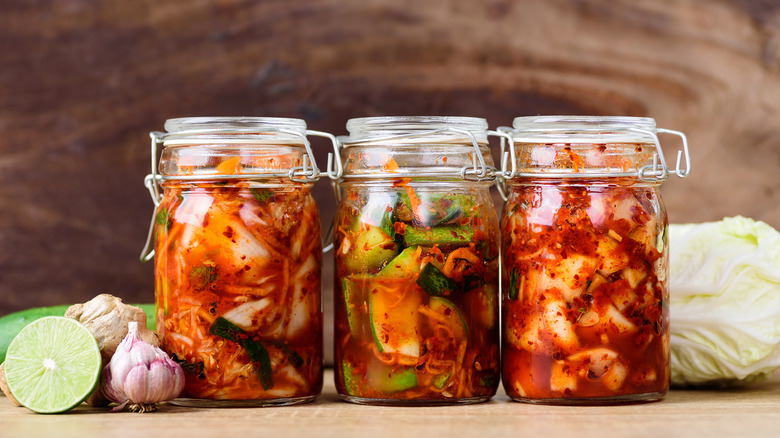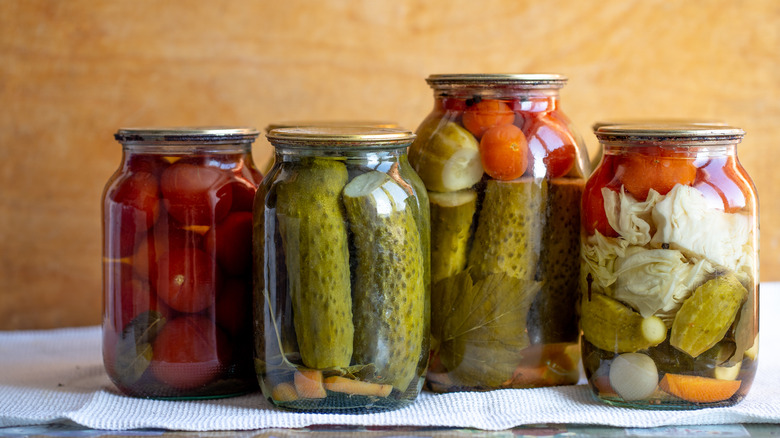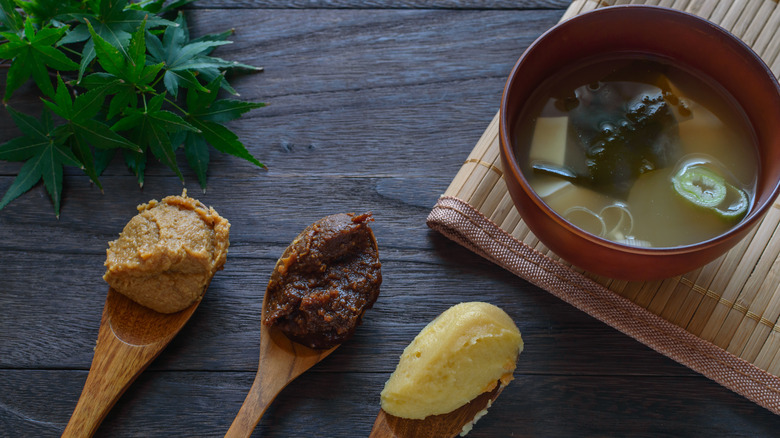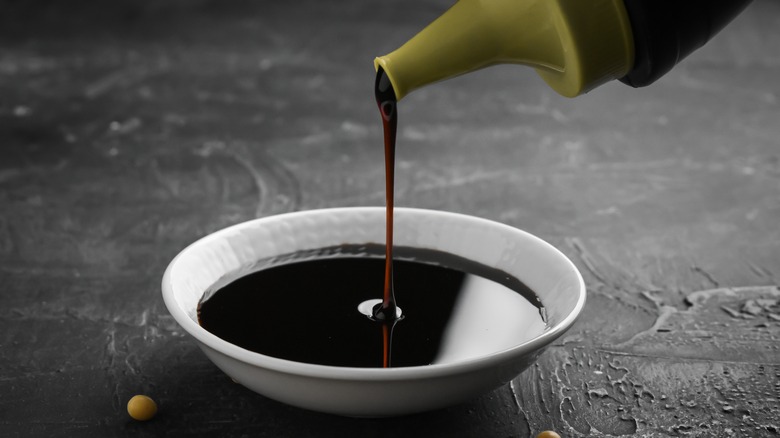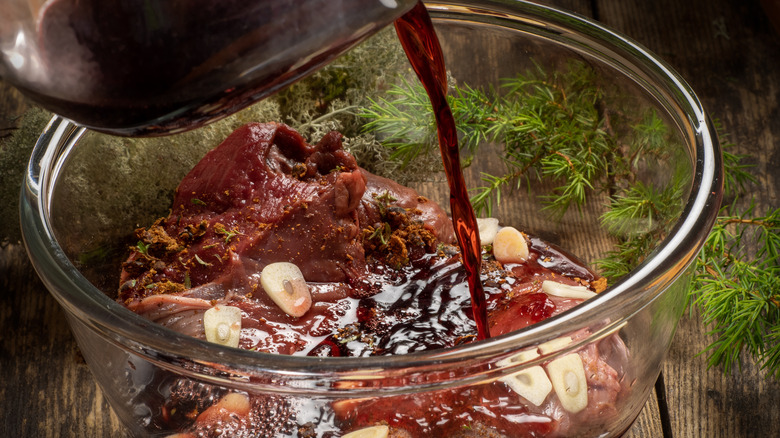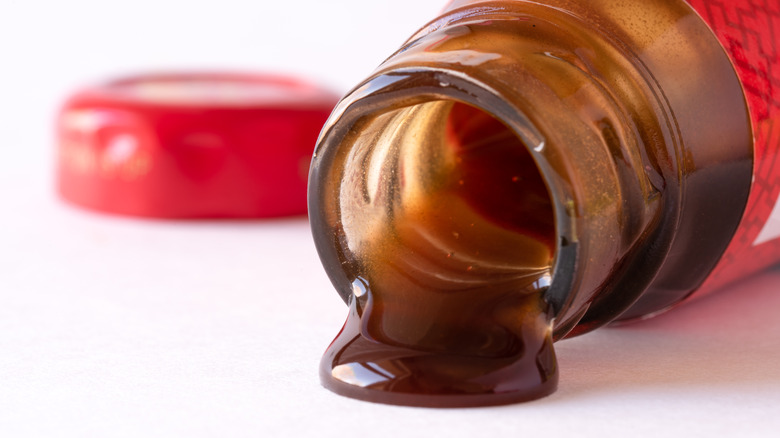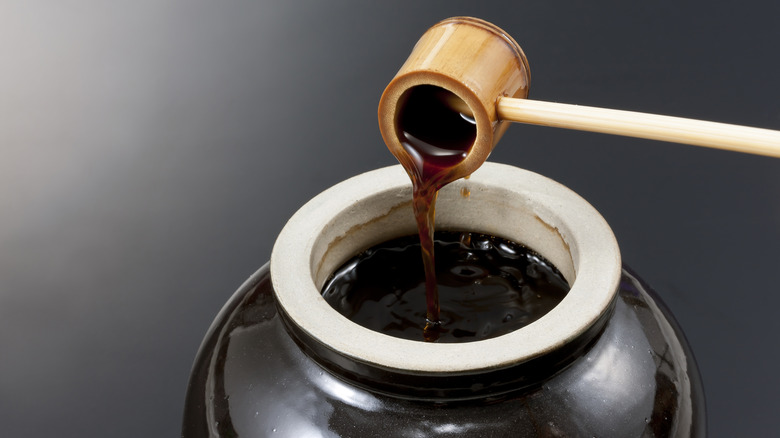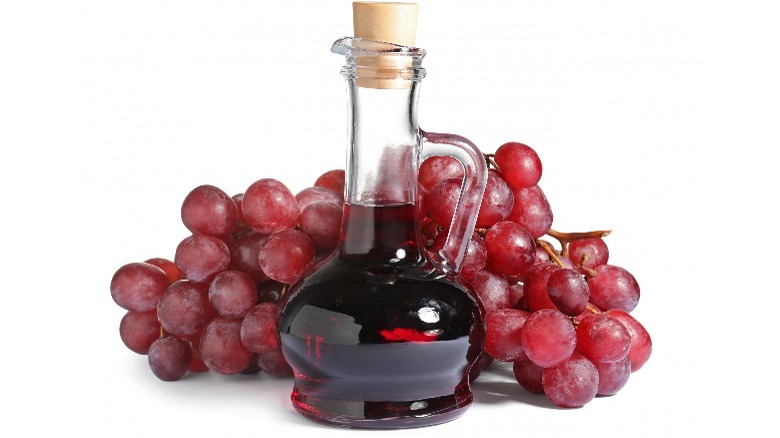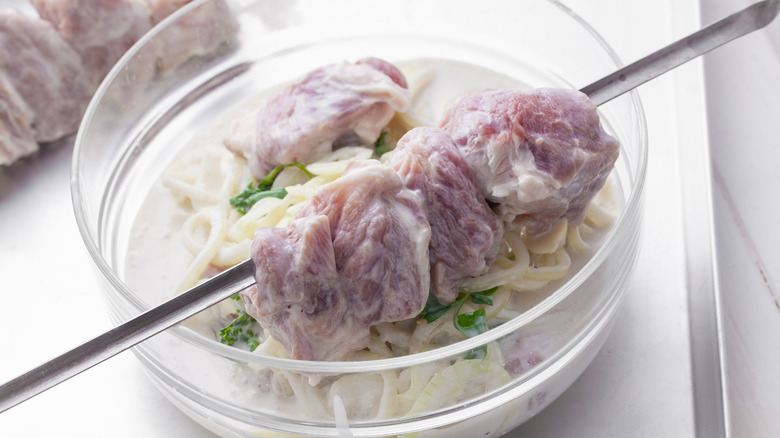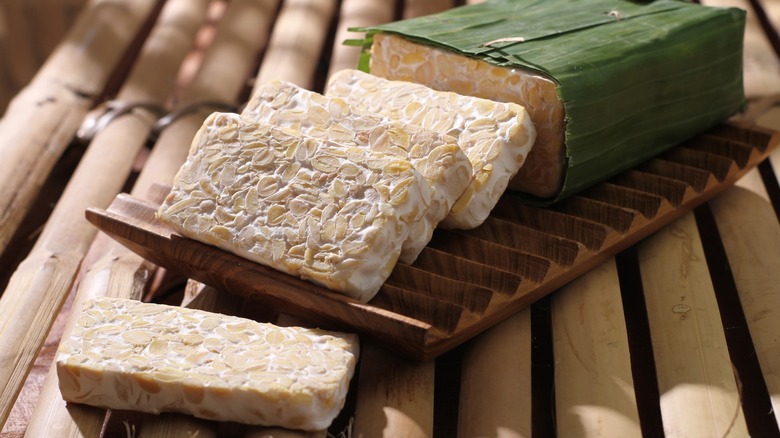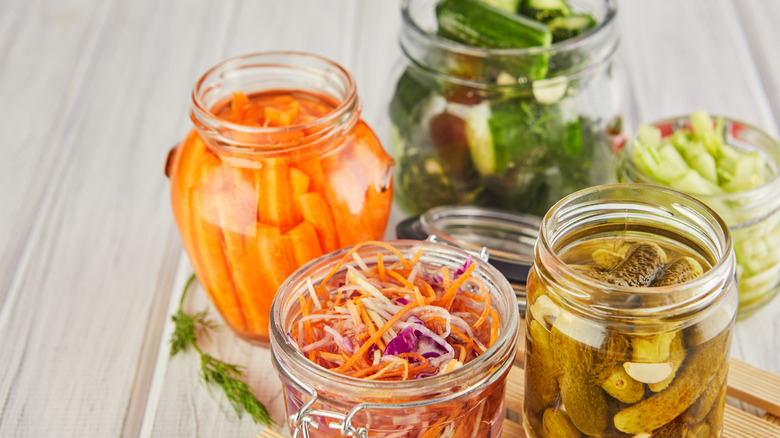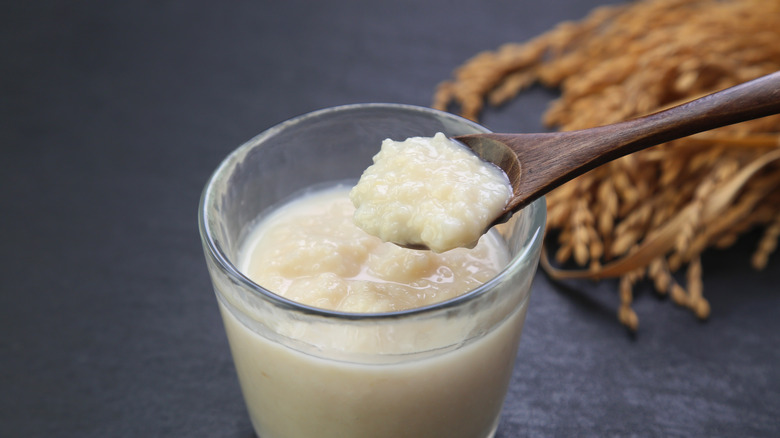13 Tips You Need When Cooking With Fermented Ingredients
When you were little, anything "funky" was to be avoided at all costs. But as we get older, that starts to mean something different — something good. Fermented foods often have a bit of funkiness, but in a good way. A very good way.
Caused by the activities of beneficial bacteria, mold, and yeast, fermentation is a powerful tool used to make all kinds of food products. Kimchi, pickles, soy sauce, miso, vinegar, tempeh, and more are all products of fermentation. Fermented foods aren't just delicious, they're also good for you. A lot of recent research has focused on the importance of gut health, and eating fermented foods is one of the best ways to promote a healthy digestive tract.
Many fermented foods are used as a garnish or flavoring, and some are used as part of a cooking process. As with any ingredient, it behooves you to use fermented food products correctly. You should understand the differences between different types of soy sauce and how to use each one, for example. You should also understand that fermented foods are living products and should be treated accordingly. Doing so will help you get the most flavor out of a fermented ingredient and the most health benefits. With that out of the way, let's get funky.
If it's old, check for mold
We mostly think of fermentation as a way to add flavor or make something from raw ingredients. However, fermentation came about as a way to make food last for weeks and even months. So, when you stick fermented foods in the refrigerator, you should expect them to keep for quite a long time. However, unlike Twinkies, fermented foods won't last forever.
Kimchi, pickles, and other foods made with lacto-fermentation will last inside your fridge for several months. If these ferments contain a high amount of salt, they should last significantly longer than those with lower salt content. Also, commercially-made ferments are typically made with ingredients and processes that help to prolong their shelf life, while homemade ferments won't last quite as long. An easy way to tell if your kimchi or pickles have gone bad is to inspect them. If you see any mold or detect any unappetizing odors, you should probably toss that fermented food in the garbage.
Miso is another fermented food that should keep in your fridge for a long time, but not forever. The length of time miso will last in the refrigerator depends on how long it has been fermented. Red miso has been fermented for much longer than white miso and therefore will last longer. Like with kimchi, if you see any discoloration or smell strange odors coming from your miso, it is time to throw it in the trash.
Recognize the difference between fermented and pickled produce
Fermented and pickled foods have a lot in common: They both have a long shelf life and a tangy flavor. However, they are quite different. Say the word "pickle" to someone and they will likely imagine a sour, dill-flavored variety of cucumber. While the word pickle is most strongly associated with this specific food item, you can pickle all kinds of things, including vegetables, fruits, eggs, and fish. The pickling process involves preserving food by submerging it in an acid, usually some type of vinegar. This acidic environment prevents pathogenic bacteria from growing both inside the food and on its exterior. These pathogens not only make us sick, but they also produce enzymes that break down food. Thus, pickling a food prolongs its shelf life.
The process of fermentation also involves preserving food by submerging it in acid. However, that acid comes from the activity of beneficial lactobacillus bacteria, not vinegar. When food is submerged in a brine, it creates an environment that allows lactobacillus to thrive, by feeding on the sugars in the food. The bacteria convert those sugars into acid, carbon dioxide, and alcohol, all of which help to preserve the food by creating an environment that is hostile to pathogenic bacteria.
Use the right type of miso
If you have seen miso in your grocery store, odds are, it was white miso, which is the most popular type. Also called shiro, white miso is typically made with koji-inoculated white rice or barley added to the ground soybeans. This miso is lightly salted and aged for three to four weeks. The flavor of white miso tends to be sweet and nutty, especially compared to other types of miso. White miso is most commonly used as a soup base, but it's also popular as an umami booster in marinades, spreads, dips, salad dressings, and baked goods.
While there are countless types of miso, there are two other types of popular miso you need to know about: yellow and red. All types of miso have different flavor profiles, and therefore, different uses. Yellow miso has been fermented for longer than white miso and as a result, it has a more acidic, deeper flavor. The flavor of yellow miso isn't as delicate as that of white miso, and that makes it more versatile as an ingredient. Unlike white miso, yellow miso won't get lost in marinades or sauces that contain a lot of other bold flavors.
Fermented for longer than both white and tallow miso, red miso has the most robust flavor profile of the three. The bold flavor of red miso can overpower a lot of milder ingredients, and so its power is best flexed in bold marinades and sauces.
Don't boil miso soup
Miso is made through the fermenting action of a beneficial mold called koji. In addition to converting soybeans into miso, koji is also a probiotic that promotes gut health. But in order to get the most health benefit out of this amazing mold, you need to consume it in an alive and active state.
Because koji degrades at high temperatures, one of the biggest mistakes you could make with miso soup is having your miso in a pot of boiling liquid. It might be a bit counterintuitive, but you should think of miso as a finishing ingredient in your miso soup recipe, rather than a foundational ingredient. Start by simmering your stock with mushrooms, onions, soy sauce, and other ingredients. While it's simmering, remove a ladle full of stock, place it in a small bowl, and allow the stock to cool. Add miso to the cooled and whisk to create a slurry. After your stock is fully flavored and the ingredients are cooked, remove the stock pot from the heat and allow it to cool slightly before adding your miso slurry.
Tofu is another ingredient that needs to be added at the end of your miso soup recipe. Boiling tofu makes it tough, so adding it at the end of the recipe keeps your tofu silky and tender. Both tofu and miso should be treated as delicate ingredients if you want to get the most out of these amazing fermented foods.
Make sure you're using the right kind of soy sauce
Made from fermented soybeans, soy sauce adds salt and umami to any dish. There are many different types of soy sauce out there, and one of the biggest mistakes you could be making while cooking with soy sauce is treating them as interchangeable. Obviously, if your recipe calls for a specific type of soy sauce, like tamari, you should follow directions and use the type of sauce that's specified. But there are times when the type of soy sauce isn't specific, and this means it's decision time.
Light soy sauce — or "regular" soy sauce — is the most popular variety and all-purpose sauce, with a mild flavor that works in most recipes. If you are making stir fry, wonton soup, or another popular Asian dish, you can't go wrong with light soy sauce. Tamari is a gluten-free alternative to soy sauce that is less salty and milder, almost floral flavor. Tamari is best for delicate applications like sushi or tempura. If you're looking for a shot of umami, opt for a Chinese soy sauce. Resembling espresso in its appearance, Chinese soy sauce is best when you need it to stand up to bold aromatics like anise, garlic, and ginger.
Be careful when using kombucha to tenderize steak
Conventional marinades contains some kind of acid — vinegar or citrus juice — that tenderizes meat by breaking down tough connective fibers in the muscle. Standard marinades also include seasonings for flavor and sugar, which adds flavor by caramelizing when it's cooked. Being acidic, sweet, and slightly savory, kombucha has all the essential qualities of a conventional marinade.
Kombucha can produce a tender steak thanks to something that conventional marinades do not have: microbial activity. Kombucha is made with a SCOBY, which stands for symbiotic colony of bacteria and yeast. These beneficial microbes convert sweetened black or green tea into kombucha by breaking down the sugar to produce acid, carbon dioxide, and a little bit of alcohol. It's the microbial activity of beneficial yeast and bacteria that translates into the gut health benefits of drinking kombucha.
This microbial activity in kombucha also helps to break down tough connective fibers in a steak, along with kombucha's acidity and alcohol. Marinating a steak in kombucha also infuses it with the fermented drink's specific flavors, which you can add to if you like. For example, if you're using lemon kombucha as a marinade, you could also add other ingredients that go with lemon, like parsley or soy sauce. Just be sure you don't over-marinate your steak when using kombucha. About 20 minutes should be long enough. Any longer and you run the risk of kombucha breaking down the meat, giving the steak a mealy quality.
Don't confuse fish sauce with oyster sauce
Judging by their names, fish sauce and oyster sauce might seem interchangeable, but they are actually quite different from one another. To understand the difference, it helps to know how each one was created. Fish sauce was developed many centuries ago, and it involves fermenting many different kinds of seafood together with salt in large clay pots. Oyster sauce was invented in 1888 when Chinese chef Lee Kum Sheung overcooked broth for oyster soup, causing it to become thick and caramelized.
Although fish sauce and oyster sauce are both based on seafood, their different production processes yield two very different end products. Fish sauce is runny, salty, and pungent. Oyster sauce is viscous and salty, yet slightly sweet. Understandably, each sauce is used slightly differently. Although, both of them often end up in the same dish. When it comes to substituting one for another, it is easier to replace oyster sauce using fish sauce that has been sweetened significantly. It is much harder to replace fish sauce with oyster sauce because the latter doesn't have the same deep umami flavors and pungent fishy aroma.
When substituting, it's also important to remember that each sauce has a different consistency. Adding a sugary syrup to fish sauce can make it somewhat more viscous, but it still likely won't be the same as oyster sauce.
Understand the different types of black vinegar
Black vinegar is somewhat similar to balsamic vinegar in that both are less acidic compared to other vinegars, and both have highly complex flavors. However, that's where the comparisons end. While balsamic vinegar can have sweet and fruity qualities, deep earthy flavors make black vinegar quite unique.
Black vinegar traditionally comes from China, and each region of the Asian country produces a distinct variety of black vinegar. For example, Sichuan black vinegar is heavily spiced and incorporates the region's signature spicy peppercorns, while black vinegar from Fujian province incorporates a fungus that gives it a reddish color. There are also black vinegars from Japan and Korea that have their own unique flavor profiles. Black vinegar from Taiwan is typically infused with onions, mushrooms, carrots, and other vegetables for at least one year.
Because the flavors of black vinegar can vary so much from region to region and country to country, it's important to check the label of a bottle before trying it for the first time. For example, Taiwanese black vinegar has a strong flavor and should be used sparingly, while milder black vinegars are often mixed with soy sauce and used as a condiment.
If you're looking for delicate flavors, buy high-quality red wine vinegar
High-quality red wine vinegars have well-rounded and complex flavors that can elevate any dressing, sauce, or marinade. So, what should you look for when buying high-quality red wine vinegar? Start by checking the label to see if it lists the type of grapes used to make the vinegar. Many high-quality red wine vinegars will list Shiraz as the grape used. This is because the bold flavors of Shiraz grapes still shine through after being converted into vinegar.
If you have a favorite bottle of red wine, you can also make high-quality red wine vinegar at home in just a few steps. Before you start, make sure the red wine you are using is either low-sulfite or sulfite-free, as the bacteria that make vinegar don't like sulfur dioxide. Also, too much alcohol can kill off vinegar-making bacteria, so choose a wine that has an ABV of 12% or less. Once you have your 750-milliliter bottle of red wine, combine it with ½ cup of unpasteurized vinegar in a half-gallon wide-mothed jar. Then, add potable water until the jar is three-fourths full. Cover the jar with a cheesecloth and secure it with string. Place the jar in a dark location at 70 to 80 degrees Fahrenheit for three to four weeks, tasting at three weeks to see if it's done.
If you're using Greek yogurt for a marinade, add lemon juice
Containing acid and active cultures, yogurt is a highly effective marinade for meat. In fact, mildly-acidic yogurt is an ideal marinade for chicken, which can become tough and rubbery in highly-acidic marinades.
In addition to tenderizing and adding flavor, yogurt marinades also create a uniquely flavorful crust when cooked. When meat soaked in standard barbecue marinade hits the grill, sugar in the marinade is caramelized to create a golden brown crust. When meat marinated in yogurt hits the grill, the lactose in yogurt quickly caramelizes, but the fat and other milk solids create a softer, juicier exterior.
If you are looking to make a yogurt marinade, the go-to option is plain, unstrained yogurt. However, many people use Greek yogurt because it's high in protein and low in fat, making it a healthier choice than fattier yogurts. Because there isn't a lot of moisture in Greek yogurt, you'll have to loosen it up a bit with lemon juice if you're using it for a marinade. Many people use Mediterranean or Middle Eastern spices when flavoring a yogurt marinade, but don't be afraid to experiment with different flavors.
Season liberally when cooking with tempeh
If you aren't vegetarian, you may have seen tempeh on your local restaurant menu and wondered what it is. Popular in the American vegetarian community since the 1980s, tempeh is a fermented soybean ingredient that's a staple in Indonesia.
It is traditionally made by boiling and then soaking soybeans overnight before cutting them in half and removing the outer hull. The halved soybeans are then inoculated with a beneficial fungus called Rhizopus oligosporus, formed into bricks, and wrapped in banana leaves or plastic bags for one to two days. The result is a white compact cake with a fibrous texture caused by the mycelium of the fungus. You can purchase tempeh as raw or pasteurized, but pasteurized tempeh is what's typically available at your local market. If there is a known tempeh producer in your area that sells the raw product, seek it out because pasteurization tends to remove a good amount of flavor.
When cooking with plant-based tempeh, it is important to season liberally. This meat alternative doesn't usually contain much salt, so you'll have to add a good amount to amplify the flavor of your tempeh. Also, tempeh is great at absorbing flavors so feel free to experiment with many different herbs and spices.
Lacto-ferments are (usually) best for finishing dishes
Declared "The Best Restaurant in the World," Noma is known for using fermented ingredients in many of its dishes. In fact, the Danish restaurant has an entire section of its kitchen dedicated to creating new, and unique fermented foods.
In "The Noma Guide to Fermentation" book, there's an entire chapter dedicated to making your own ferments using lactobacillus bacteria. The book describes how using salt and time can allow latent lactobacillus bacteria to thrive, teasing out unique flavors from things like mushrooms, blueberries, and tomatoes. While the book is full of cool food science experiments, it also goes the extra step of explaining how the results of your experiments can actually be used in your kitchen.
In the lacto-fermentation chapter, chefs David Zilber and René Redzepi describe how fermented blueberries can be used as a spread on fresh-roasted corn and how fermented tomato water can be used to flavor raw seafood. While there are one or two exceptions, the overarching theme of these applications is using lacto-ferments as a finishing tool. These fermented foods have complex flavor qualities that will get lost if they are tossed into a hot oven or boiling pot of water. Therefore, you should think of using these fermented foods when all your cooking is done.
Don't overexpose fish to koji
Koji is a strain of fungus that's been used in Japanese cuisine for centuries, but in the past decade or so, koji has become a go-to ingredient in forward-thinking restaurants around the world. One popular application of koji is to use it as a dry rub for meat or seafood. The microbial activity of the koji breaks down the meat to tenderize it and produce deeper flavors.
In fact, rubbing koji on a steak and allowing it to sit in your refrigerator for 48 hours can give you something similar to a dry-aged steak that takes weeks to produce. This is one of the best ways to use koji, and it's something you can do at home. All you need to do by a bag of koji-inoculated rice, grind it up, rub it on a steak, and let that steak sit in your fridge for 48 hours.
You can also use a similar technique to add flavor to seafood, according to "The Noma Guide to Fermentation." Simply blend koji, salt, and water to produce a paste that you rub onto your fish. It's important to use fish that has meaty flesh, as thin filets are prone to becoming salty and hard. It's also important to limit the marinade time to 10 or 15 minutes. Any longer will cause your fish to become too salty.
Static Media owns and operates Tasting Table and The Daily Meal.
